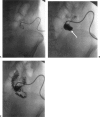Management of enterocutaneous fistulas
- PMID: 20011252
- PMCID: PMC2780046
- DOI: 10.1055/s-2004-828654
Management of enterocutaneous fistulas
Abstract
Despite advances in antimicrobial chemotherapy, nutritional support, and perioperative critical care, the development of an enterocutaneous fistula continues to represent a major therapeutic challenge, with appreciable morbidity and mortality. Specific problems that must be addressed for the successful management of patients with enterocutaneous fistulas are the control of sepsis, maintenance of adequate fluid and electrolyte balance, provision of adequate and complication-free nutritional support, and skin-stoma care. In addition, many patients with postoperative intestinal fistulation suffer from significant psychological morbidity, which must be addressed during often prolonged periods of rehabilitation. The complex nature of the care required for successful management of patients with enterocutaneous fistulas mandates a multidisciplinary team approach, with specialist nurses, dieticians, pharmacists, radiologists, physicians, and surgeons all having important roles to play.
Keywords: Sepsis; fistuloclysis; laparostomy; parenteral nutrition.
Figures






Similar articles
-
Artificial nutritional support in patients with gastrointestinal fistulas.World J Surg. 1999 Jun;23(6):570-6. doi: 10.1007/pl00012349. World J Surg. 1999. PMID: 10227926 Review.
-
Exploration of critical care nurses' challenges in caring for enterocutaneous fistula as a complication for an open abdomen: A qualitative study.Health Sci Rep. 2024 May 13;7(5):e2051. doi: 10.1002/hsr2.2051. eCollection 2024 May. Health Sci Rep. 2024. PMID: 38742090 Free PMC article.
-
Considerations for the management of enterocutaneous fistula.Br J Nurs. 2019 Mar 14;28(5):S24-S31. doi: 10.12968/bjon.2019.28.5.S24. Br J Nurs. 2019. PMID: 30907655
-
Nutritional Management of Patients With Enterocutaneous Fistulas: Practice and Progression.Front Nutr. 2020 Oct 6;7:564379. doi: 10.3389/fnut.2020.564379. eCollection 2020. Front Nutr. 2020. PMID: 33123545 Free PMC article. Review.
-
Nutritional management of enterocutaneous fistulas.Br J Nurs. 2009 Feb 26-Mar 11;18(4):225-30. doi: 10.12968/bjon.2009.18.4.39619. Br J Nurs. 2009. PMID: 19462583
Cited by
-
Bletilla striata promotes the healing of enterocutaneous fistula: A case report.Medicine (Baltimore). 2019 Jul;98(27):e16288. doi: 10.1097/MD.0000000000016288. Medicine (Baltimore). 2019. PMID: 31277160 Free PMC article.
-
Assessment and management of patients with intestinal failure: a multidisciplinary approach.Clin Exp Gastroenterol. 2018 Jun 12;11:233-241. doi: 10.2147/CEG.S122868. eCollection 2018. Clin Exp Gastroenterol. 2018. PMID: 29928141 Free PMC article. Review.
-
From an Enteroatmospheric to an Enterocutaneous Fistula Using a Condom.Cureus. 2024 Nov 22;16(11):e74209. doi: 10.7759/cureus.74209. eCollection 2024 Nov. Cureus. 2024. PMID: 39712812 Free PMC article.
-
Catheter Injectable Multifunctional Biomaterial for the Treatment of Infected Enterocutaneous Fistulas.Adv Sci (Weinh). 2025 May;12(20):e2414642. doi: 10.1002/advs.202414642. Epub 2025 Feb 14. Adv Sci (Weinh). 2025. PMID: 39950851 Free PMC article.
-
Enterocutaneous Fistula: Proven Strategies and Updates.Clin Colon Rectal Surg. 2016 Jun;29(2):130-7. doi: 10.1055/s-0036-1580732. Clin Colon Rectal Surg. 2016. PMID: 27247538 Free PMC article. Review.
References
-
- Gomella L G, Lefor A T. Surgery on Call. Norwalk, CT: Appleton-Lange; 1990.
-
- Nightingale J MD. In: Nightingale JMD, editor. Intestinal Failure. London: Greenwich Medical Media; 2001. The short bowel. pp. 177–198.
-
- Nightingale J MD, Walker E R, Farthing M JG, Lennard-Jones J E. Effect of omeprazole on intestinal output in the short bowel syndrome. Aliment Pharmacol Ther. 1991;5:405–412. - PubMed
-
- Paran H, Neufeld D, Kaplan O, Klausner J, Freund U. Octreotide for treatment of postoperative alimentary fistulas. World J Surg. 1995;19:430–433. - PubMed
LinkOut - more resources
Full Text Sources
Other Literature Sources

